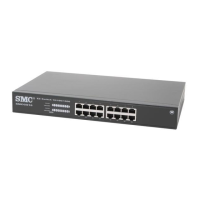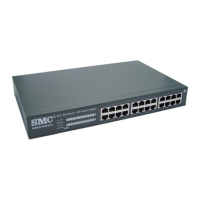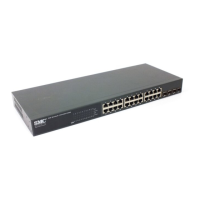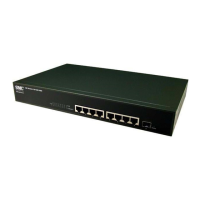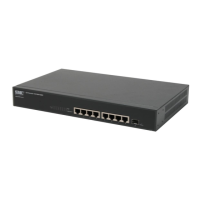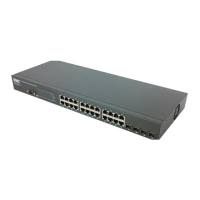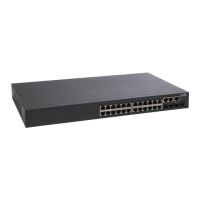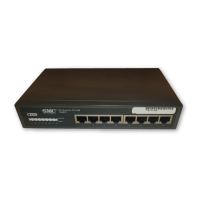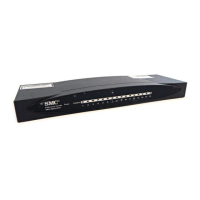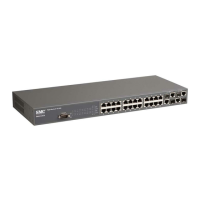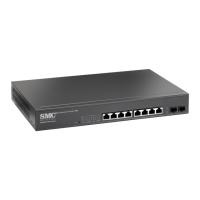
Do you have a question about the SMC Networks SMCGS10P-Smart and is the answer not in the manual?
| Brand | SMC Networks |
|---|---|
| Model | SMCGS10P-Smart |
| Category | Switch |
| Language | English |
Explains the guide's objective: to provide specific information on operating and using the switch's management functions.
Identifies the guide's target users as network administrators responsible for operating and maintaining network equipment.
Details the conventions used throughout the guide to present information, including NOTE, CAUTION, and WARNING.
Refers to the Installation Guide for hardware features and online help for management features.
Summarizes the changes made in each revision of the guide, listing specific revisions and their changes.
Provides an overview of the switch's Layer 2 switching features and management agent capabilities.
Details the essential procedures for connecting and performing the initial IP configuration of the switch.
Summarizes the switch's key features, including configuration, authentication, security, and port functionalities.
Details the switch's advanced performance-enhancing features like flow control, storm suppression, and VLANs.
Lists the default system settings for various functions like authentication, port configuration, and IP settings.
Explains how to configure IPv4 and IPv6 interfaces for management access to the switch.
Guides on configuring IPv4 address, subnet mask, and default gateway for the switch.
Details IPv6 configuration, including link-local and global unicast addresses, and auto-configuration.
Describes how to configure Network Time Protocol (NTP) servers for accurate time synchronization on the switch.
Explains how to send system log messages to syslog servers and limit message types for monitoring.
Introduces the embedded HTTP web agent for switch configuration and monitoring via a web browser.
Covers basic configuration tasks for the switch, including system information and IP settings.
Explains how to access the web interface, including the default administrator login credentials.
Describes the switch's home page layout, including the Main Menu and front panel image.
Details the web page configuration buttons like Save, Reset, and Help, and provides notes on screen refresh.
Explains the panel display feature, which shows a switch's ports, and how to use auto-refresh and refresh functions.
Provides a brief description of the selections available in the switch's web interface main menu.
Guides on identifying the system by configuring contact info, name, location, and timezone offset.
Details how to configure an IP interface for management access, supporting both IPv4 and IPv6.
Guides on configuring IPv4 address, subnet mask, and default gateway for the switch.
Details IPv6 configuration, including link-local and global unicast addresses, and auto-configuration.
Describes how to configure Network Time Protocol (NTP) servers for accurate time synchronization on the switch.
Explains how to send system log messages to syslog servers and limit message types for monitoring.
Details power saving methods including LED intensity control and powering down idle queue circuits.
Explains how to reduce LED intensity during specified hours to save power.
Details the configuration of Energy Efficient Ethernet (EEE) for specified queues and urgent queues.
Guides on setting temperature priority levels for port shut-down when exceeding temperature thresholds.
Explains how to configure connection parameters for each port, including speed, duplex, and flow control.
Outlines security measures including management access, general security, and user account configuration.
Details controlling management access via local authentication, RADIUS, TACACS+, SSH, HTTPS, and static IP.
Outlines methods for traffic segregation, including Private VLANs, 802.1X, DHCP Snooping, and ARP Inspection.
Describes controlling management access by configuring user names, passwords, and privilege levels.
Explains how to set privilege levels for specific software modules or system settings.
Specifies authentication methods for management access via console, Telnet, SSH, or HTTP/HTTPS.
Details how to configure Secure Shell (SSH) access for secure remote management.
Guides on enabling Secure Hypertext Transfer Protocol (HTTPS) for secure web interface access.
Explains how to create a list of allowed IP addresses for management access via web, SNMP, or Telnet.
Introduces SNMP, its versions, and access control via community strings and SNMPv3 security models.
Covers basic SNMP settings and trap configuration for reporting key events to a management station.
Details setting community access strings for SNMPv1 and v2c clients and managing source IP/mask.
Explains how to define unique names, engine IDs, security levels, and protocols for SNMPv3 users.
Guides on configuring SNMPv3 groups to define access policies for users and restrict access to MIB objects.
Describes defining views to restrict user access to specific portions of the MIB tree.
Details assigning MIB tree portions to SNMPv3 groups for read and write access.
Explains how to limit the number of users (MAC addresses) accessing a port and define responses to violations.
Guides on configuring IEEE 802.1X port-based and MAC-based authentication settings.
Illustrates how Port Security works with EAPOL and RADIUS for client authentication and access control.
Explains Access Control Lists (ACLs) for permit/deny conditions on IP addresses, MAC addresses, and frame types.
Guides on defining ACL policies and responses for a port, including frame copying, logging, and shutdown.
Details defining rate limits applied to ports, configured via ACLs, for ingress traffic.
Explains defining filtering rules for ACL policies, specific ports, or all ports.
Details ingress port and frame type criteria for Access Control Entries (ACEs).
Explains filtering IP traffic on insecure ports by tracking hosts and preventing rogue DHCP servers.
Guides on configuring DHCP relay service and using DHCP Option 82 for client identification.
Details filtering IP traffic based on static or dynamic entries to prevent IP address spoofing attacks.
Explains enabling IP Source Guard globally and for specific ports to filter traffic based on IP/MAC binding tables.
Guides on binding static IP addresses to ports using the IP Source Guard table for security.
Explains validating MAC address bindings for ARP packets to prevent man-in-the-middle attacks.
Guides on enabling ARP inspection globally and for specific ports to validate IP-to-MAC bindings.
Details binding static IP-to-MAC addresses for ARP Inspection to validate ARP packets.
Guides on configuring RADIUS or TACACS+ servers for management access and 802.1X port authentication.
Explains creating virtual aggregate links by grouping multiple physical links for increased bandwidth and fault tolerance.
Details configuring aggregation mode and members for static trunk groups, compatible with Cisco EtherChannel.
Guides on enabling LACP on selected ports, configuring administrative key, and protocol initiation mode for dynamic trunks.
Explains the Spanning Tree Algorithm (STA) for detecting and disabling network loops and providing backup links.
Guides on configuring global settings for Spanning Tree Algorithm (STA), including protocol version and bridge priority.
Details configuring MSTP instances and mapping VLANs to MST instances for improved network resource utilization.
Explains configuring bridge priority for CIST and MSTI instances, crucial for root bridge and port selection.
Guides on configuring STA attributes for interfaces, including path cost, port priority, and edge port settings.
Explains configuring STA attributes for interfaces within a specific MSTI, covering path cost and port priority.
Describes MVR for controlling access to common multicast streams via a single network-wide VLAN.
Introduces IGMP snooping for filtering multicast traffic by monitoring IGMP messages between hosts and routers.
Guides on configuring global and port settings to control multicast traffic forwarding based on IGMP query/report messages.
Details configuring IGMP snooping and query settings per VLAN interface.
Explains filtering specific multicast traffic on ports by denying access to specified multicast services.
Introduces MLD snooping for limiting IPv6 multicast traffic forwarding to ports with users requesting it.
Details configuring MLD snooping and query settings per VLAN interface.
Explains filtering specific multicast traffic on ports by denying access to specified multicast services.
Introduces LLDP for discovering information about neighboring devices on the local broadcast domain.
Guides on setting timing attributes and device information for LLDP advertisement transmission.
Explains setting device information advertised for endpoint devices using LLDP-MED TLVs.
Details setting maximum PoE power, power budget, operating mode, priority, and allocation for ports.
Explains the three modes (Class, Allocation, LLDP-MED) for configuring how ports reserve power.
Details the two modes (Actual Consumption, Reserved Power) for configuring when ports shut down to manage power.
Guides on configuring dynamic address learning or assigning static addresses to specific ports.
Explains using VLANs to organize network nodes into separate broadcast domains for security and efficiency.
Guides on assigning ports to VLAN groups, differentiating between tagged and untagged ports.
Details configuring VLAN attributes for interfaces, including Ethertype, port type, and ingress filtering.
Guides on assigning port members to private VLANs for port-based security and isolation.
Explains preventing communications between customer ports within the same private VLAN.
Guides on configuring VLANs based on MAC addresses, assigning VLAN IDs to ingress untagged frames.
Explains configuring VLANs based on protocol types to group devices participating in specific protocols.
Guides on creating protocol groups and mapping them to VLANs for protocol-based VLAN configuration.
Recommends isolating VoIP traffic in a Voice VLAN for better quality, security, and QoS.
Guides on enabling VoIP device detection, setting Voice VLAN ID, aging time, and traffic class.
Explains using the Voice VLAN OUI table to identify VoIP devices by their MAC address OUI numbers.
Explains how to prioritize data packets based on class information for better network performance during congestion.
Guides on setting basic QoS parameters for a port, including default traffic class, DP level, and tag classification.
Details setting classification modes for tagged frames and mapping PCP/DEI to QoS class and DP level.
Explains showing overview of QoS Egress Port Schedulers, including queue mode and weight.
Guides on configuring scheduler mode, queue shaper, queue scheduler, and port shaper for egress ports.
Explains showing overview of QoS Egress Port Shapers, including rate for each queue and port.
Guides on showing overview of QoS Egress Port Tag Remarking mode and configuring remarking using PCP/DEI values.
Explains configuring ingress DSCP translation, classification, and egress rewriting of DSCP values.
Guides on configuring DSCP-based QoS ingress classification settings, including trusting DSCP values.
Details configuring DSCP translation for ingress traffic or DSCP re-mapping for egress traffic.
Guides on mapping DSCP values to QoS class and drop precedence level.
Explains configuring QoS policies for handling ingress packets based on various criteria like Ethernet type, VLAN ID, and DSCP.
Guides on setting limits for broadcast, multicast, and unknown unicast traffic to control traffic storms.
Explains mirroring traffic from source ports to a target port for real-time analysis using logic analyzers or RMON probes.
Details configuring Universal Plug and Play (UPnP) for seamless device connectivity and simplified network deployment.
Explains how to use the Monitor/System menu to display switch descriptions, logs, and traffic statistics.
Guides on identifying the system by displaying device name, location, contact, hardware, and time information.
Details how to display CPU utilization information, with graphs averaged over different intervals.
Explains how to scroll through logged system and event messages using the System Log Information page.
Guides on viewing the full text of specific log messages using the Detailed Log page.
Explains how to show the thermal status for each port and the current chip temperature.
Describes how to display port status, traffic statistics, and service queue information via the Monitor/Port menu.
Guides on displaying an image of the switch's ports via the Port State Overview page.
Explains how to display a summary of basic information on traffic crossing each port using Port Statistics Overview.
Details how to display the number of packets processed by each service queue using Queuing Counters.
Guides on showing QoS Control List (QCE) entries and checking for conflicts using the QoS Control List Status page.
Explains how to display detailed statistics on network traffic per port to identify potential issues.
Describes how to display statistics on management traffic, client access controls, and authentication server status.
Guides on viewing statistics on traffic used for managing the switch via HTTP, HTTPS, SNMP, Telnet, and SSH.
Explains how to show MAC address learning status, software module requests, and learned address limits per port.
Guides on showing authorized MAC entries per port, including address, VLAN ID, state, and age/hold.
Explains how to show port status for authentication services, including 802.1X state, last source, and last ID.
Guides on displaying authentication statistics for selected ports, focusing on 802.1X or backend server data.
Explains how to show ACL status, including ingress port, frame type, and forwarding action for each ACE.
Guides on showing statistics for various types of DHCP protocol packets, including Discover, Offer, and ACK.
Explains how to display statistics for the DHCP relay service and its clients.
Guides on opening the Dynamic ARP Inspection Table to view sorted address entries by port, VLAN, MAC, and IP.
Explains opening the Dynamic IP Source Guard Table to display sorted entries by port, VLAN ID, MAC, and IP address.
Guides on displaying RADIUS authentication and accounting server information, including IP address and status.
Explains how to display a list of configured authentication and accounting servers using the RADIUS Overview page.
Guides on displaying statistics for configured authentication and accounting servers using RADIUS Details.
Explains using monitor pages for LACP to display configuration settings, port status, and control packet statistics.
Guides on displaying an overview of LACP groups active on the switch using the LACP System Status page.
Explains displaying information on LACP groups active on each port using the LACP Port Status page.
Guides on displaying statistics on LACP control packets crossing each port using the LACP Port Statistics page.
Explains using monitor pages for Spanning Tree to display bridge status, port status, and protocol packet statistics.
Guides on displaying STA information on the global bridge and individual ports using the Bridge Status page.
Explains displaying STA functional status of participating ports using the Port Status page.
Guides on displaying statistics on spanning tree protocol packets crossing each port using the Port Statistics page.
Explains using monitor pages for MVR to display MVR statistics and active multicast groups.
Guides on displaying statistics for IGMP protocol messages used by MVR, including VLAN ID and reports received.
Explains displaying statistics for IGMP messages used by MVR and interfaces associated with multicast groups.
Guides on displaying IGMP snooping statistics, port members, and source-specific group information.
Explains displaying IGMP querier status, snooping stats per VLAN, and ports connected to multicast routers.
Guides on displaying port members of each service group in IGMP snooping.
Explains displaying IGMP Source-Specific Information, including group, filtering mode, source address, and type.
Guides on displaying MLD snooping statistics, port members, and source-specific group information.
Explains displaying MLD querier status and snooping statistics per VLAN carrying multicast traffic.
Guides on displaying port members of each service group in MLD snooping.
Explains displaying MLD Source-Specific Information, including group, filtering mode, source address, and type.
Explains using monitor pages for LLDP to display advertised information from neighbors and control frame statistics.
Guides on displaying information about devices connected directly to switch ports advertising LLDP information.
Explains displaying information about remote devices advertising LLDP-MED TLVs, including capabilities and policy.
Guides on displaying Energy Efficient Ethernet information advertised through LLDP messages.
Explains displaying statistics on LLDP global counters and control frames.
Guides on displaying status of LLDP PoE neighbors, including power device type, source, priority, and required power.
Explains displaying status for all PoE ports, including PD class, requested, allocated, used power, and priority.
Guides on displaying dynamic and static address entries associated with the CPU and each port.
Explains using monitor pages for VLANs to display port members and attributes assigned to each port.
Guides on displaying current port members for all VLANs configured by a selected software module.
Explains displaying VLAN attributes of port members, including PVID, ingress filtering, and frame type.
Guides on displaying MAC address to VLAN map entries using the MAC-based VLAN Membership Configuration page.
Explains using the Ping page to send ICMP echo request packets to test network connectivity.
Guides on performing cable diagnostics for ports to diagnose faults like shorts or opens and report cable length.
Details the procedure to restart the switch using the Restart Device page.
Explains restoring the original factory settings, including LAN IP, Subnet Mask, and Gateway IP.
Guides on upgrading the switch's system firmware by specifying a file provided by SMC/Edge-Core.
Covers saving current configuration to a file or restoring previously saved settings.
Lists software features related to management, client access, port configuration, quality of service, and VLANs.
Provides a troubleshooting chart for common problems, particularly those related to accessing the management interface.
Contains license information, specifically detailing the GNU General Public License terms.
